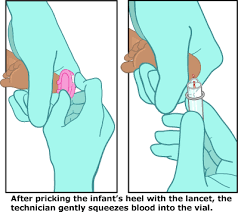Which of the following is an appropriate technique for specimen collection?
Performing a heel stick on a 5-year-old patient
Performing a finger stick on a toddler patient
Performing a thumb stick on an infant
Performing a thumb stick on a 5-year-old patient
The Correct Answer is B
Choice A reason:
Performing a heel stick on a 5-year-old patient is not an appropriate technique. Heel sticks are typically used for infants, particularly newborns, to minimize discomfort and because their finger pads may not be fully developed for finger sticks. By the age of 5, a child's veins are usually developed enough for venipuncture, which is the preferred method.
Choice B reason:
Performing a finger stick on a toddler patient is an appropriate technique for specimen collection. This method is commonly used for children who are not yet old enough for venipuncture but have outgrown the heel stick method. The finger stick is performed on the palmar surface of the distal phalanx, usually of the middle or ring finger, and is considered safe and effective for collecting small blood samples in toddlers.
Choice C reason:
Performing a thumb stick on an infant is not an appropriate technique. The thumb has a pulse and is more sensitive, which can cause unnecessary pain and distress to the infant. Additionally, the thumb's size and increased movement make it a less suitable site for specimen collection in infants.
Choice D reason:
Performing a thumb stick on a 5-year-old patient is also not an appropriate technique. As with infants, the thumb's sensitivity and the presence of a pulse make it a less desirable site for blood collection. For a 5-year-old, venipuncture or a finger stick on a non-thumb finger would be more appropriate and less distressing.

Nursing Test Bank
Naxlex Comprehensive Predictor Exams
Related Questions
Correct Answer is A
Explanation
Choice A Reason:
Standard precautions are a set of infection control practices used to prevent transmission of diseases that can be acquired by contact with blood, body fluids, non-intact skin (including rashes), and mucous membranes. These measures are to be applied to all patients, regardless of their diagnosis or presumed infection status. Standard precautions include hand hygiene, use of personal protective equipment (PPE), respiratory hygiene/cough etiquette, safe injection practices, safe handling of potentially contaminated equipment or surfaces in the patient environment, and aseptic technique.
Choice B Reason:
Safety devices, such as needles with engineered sharps injury protections, are designed to prevent needlestick injuries and the transmission of bloodborne pathogens. While they are an important aspect of a phlebotomist's work, they are not specifically part of the aseptic technique protocol. Aseptic technique focuses on preventing contamination of sterile surfaces and materials to prevent infection.
Choice C Reason:
Quality control logs are records that document the performance of equipment and procedures to ensure they meet the required standards. They are essential for maintaining the integrity of laboratory results and ensuring patient safety. However, quality control logs themselves are not a component of the aseptic technique protocol, which is more concerned with the immediate prevention of infection during clinical procedures.
Choice D Reason:
A disaster emergency plan is a comprehensive document outlining the actions to be taken in case of an emergency. This plan is crucial for ensuring safety and continuity of care during unexpected events but is not related to the aseptic technique protocol. Aseptic technique is a method used to prevent infection during medical procedures by maintaining a sterile environment.
Correct Answer is C
Explanation
Choice A Reason:
Patient's insurance information is not typically included in the follow-up documentation of a stat result. Insurance information is relevant for billing purposes and does not pertain to the immediate clinical care or the communication of test results.
Choice B Reason:
The room number of the patient might be included in the internal documentation for logistical purposes but is not the primary piece of information required following a verbal report of a stat result. The focus should be on the communication details rather than the location.
Choice C Reason:
The name of the provider contacted is essential information in the follow-up documentation after a verbal report. This ensures that there is a record of who received the information, which is crucial for accountability and continuity of care.
Choice D Reason:
The provider's phone number is not necessary in the follow-up documentation if the name of the provider is already included. The phone number would have been used to make the initial contact, and the key information is the confirmation that the provider was reached and informed of the stat result.
Whether you are a student looking to ace your exams or a practicing nurse seeking to enhance your expertise , our nursing education contents will empower you with the confidence and competence to make a difference in the lives of patients and become a respected leader in the healthcare field.
Visit Naxlex, invest in your future and unlock endless possibilities with our unparalleled nursing education contents today
Report Wrong Answer on the Current Question
Do you disagree with the answer? If yes, what is your expected answer? Explain.
Kindly be descriptive with the issue you are facing.
